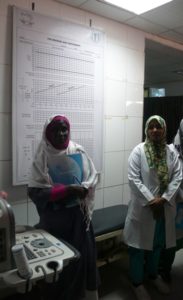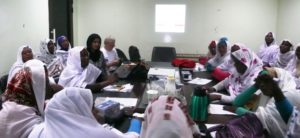
Gedaref- Midwives during the training session
A method invented by Philpott and Castle in the early 70s to facilitate the work of midwives, the partogram is intended to provide an accurate record of the progress of labour. In this way, without the use of machinery, it is possible to monitor the period before delivery: which begins, in fact, when the woman reaches a dilation of 4 cm.
In Sudan, according to World Bank data for 2015, the rate of perinatal death, related to fetus mortality after 28 weeks of pregnancy and to the new-borns in the first 24 hours, of the child’s life is 3%. This, however, is a data that includes deliveries whether in urban areas or rural areas: but it is easy to assume that the percentage might be much higher in the rural areas, because of lack of qualified staff and facilities,. Precisely through the introduction of partogram in rural areas, the Italian Cooperation wants to contribute to reducing this number, though it fell by one point in the past 26 years. In 1990, in fact, the World Bank recorded 4% in perinatal mortality rate.

An example of the partogram, translated in Arabic is used in the courses
The paper format has been standardized by World Health Organization, between the ’90s and 2000, a translation in Arabic has not been provided. In Sudan, the doctors learn how to use the partogram as part of their studies, but this theoretical knowledge often faces difficulties when put into practice, as midwives are the ones to follow the physiological parts (normal). The language barrier, in fact, makes compiling the partogram in English difficult. The Italian Cooperation, with the State Ministry of Health in Gedaref and Red Sea States, has provided both the Arabic translation of the model, in addition to the preparation of a small guide for compilation, with the aim of spreading its use to all health professionals working on maternal and child health.
The measurement of different indicators, such as the dilation of the cervix, the state of the membranes (either broken or intact), the blood pressure of the mother, the position of fetus’ head in relation to the birth canal, the heartbeat of the fetus and the mother, the colour of the amniotic fluid, the description of contractions, which comes at regular intervals during labour in order to identify as early as possible any anomalies for both mother and child.
The graphical structure of the partogram helps the health care worker to visually monitor the progress of labour and to take prompt action in case of abnormalities. At the centre of the graph there are two lines an Alert line, which suggests calling the doctor for any transfer, another line of Action, which suggests immediate action.
“The use of the partogram is crucial because it allows an immediate understanding of the evolution of labour and an early detection of a possible prolonged labour, is also an effective means of information exchange between health professionals” (WHO Recommendation) .
A first a training course took place in the Maternity and Child Hospital in Gedaref, involving twenty doctors and twenty midwives. Present in court during the lessons was Dr. Valerio Pastori, AICS staff, along with three hospital gynaecologists who have taken the training course in data logging and filling in the graph. The proper use of partogram graphic model is the winning key to prevent and to be prepared to deal with complications during delivery.
After the work done in the state of Gedaref, two more training courses took place in Maternity and Child hospitals in Sinkat and Port Sudan in the Red Sea State. The courses were for fifty three medicals and twenty-six midwives, in the six reference hospitals of the system of treatment of obstetric emergencies (EMOC) of Sinkat, Swakin and Port Sudan, targeted areas of the Italian Cooperation’s health initiatives. Dr. Mohamed Ali and Dr. Sarah Saad Aldin, trained Gynaecologists supported by the presence of Dr. Valerio Pastori and Medical Officer Riccardo Lazzaro, both staff of AICS, have completed the two cycles of six meetings in order to introduce this new tool in the routine of the delivery room.
The training in both Gedaref and Red Sea States has taken place under the project “Support to the Development of Health Systems in Gedaref, Red Sea and Kassala States and with the Integration of EU Delegated Cooperation Program” of the Italian Agency for Cooperation and Development.

Dr. Valerio Pastori together with the midwives in the lessons
Despite some initial resistance to the use of partogram, the initiative was successful and all participants were happy to have had the opportunity to learn something new. In Red Sea State, AICS colleague Riccardo Lazzaro has come to know that, after the training, Dr. Ikhlass Bady, director of maternity and child hospital “Obstetric Teaching Hospital” in Port Sudan, called for immediate insertion of the new partogram medical records issued by WHO in the structure, both in English and Arabic. “The partogram is a simple but essential tool for the prevention of obstetric emergencies, especially in rural areas where the shortage of trained personnel makes the early detection of potential problems such as eclampsia fundamental, slow delivery, and fetal distress ” has explained the director regarding the reasons for its request to use.
A second testimony of the success of the initiative comes from Elisa Edimond, state coordinator in Gedaref of Italian Cooperation’s delegated health programs. Entering the hospital delivery room, a few days after the end of the course, Elisa has found the first partograms compiled attached to folders of patients in labour, even telling image that bodes well: that of two doctors who were helping a midwife with a partogram in hand, while practising in compilation!
